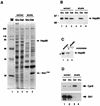SBA1 encodes a yeast hsp90 cochaperone that is homologous to vertebrate p23 proteins
- PMID: 9632755
- PMCID: PMC108955
- DOI: 10.1128/MCB.18.7.3727
SBA1 encodes a yeast hsp90 cochaperone that is homologous to vertebrate p23 proteins
Abstract
The Saccharomyces cerevisiae SBA1 gene was cloned by PCR amplification from yeast genomic DNA following its identification as encoding an ortholog of human p23, an Hsp90 cochaperone. The SBA1 gene product is constitutively expressed and nonessential, although a disruption mutant grew more slowly than the wild type at both 18 and 37 degreesC. A double deletion of SBA1 and STI1, encoding an Hsp90 cochaperone, displayed synthetic growth defects. Affinity isolation of histidine-tagged Sba1p (Sba1(His6)) after expression in yeast led to coisolation of Hsp90 and the cyclophilin homolog Cpr6. Using an in vitro assembly assay, purified Sba1(His6) bound to Hsp90 only in the presence of adenosine 5'-O-(3-thiotriphosphate) or adenyl-imidodiphosphate. Furthermore, interaction between purified Sba1(His6) and Hsp90 in yeast extracts was inhibited by the benzoquinoid ansamycins geldanamycin and macbecin. The in vitro assay was also used to identify residues in Hsp90 that are important for complex formation with Sba1(His6), and residues in both the N-terminal nucleotide binding domain and C-terminal half were characterized. In vivo analysis of known Hsp90 substrate proteins revealed that Sba1 loss of function had only a mild effect on the activity of the tyrosine kinase v-Src and steroid hormone receptors.
Figures






Similar articles
-
p23, a simple protein with complex activities.Cell Stress Chaperones. 2003 Summer;8(2):108-13. doi: 10.1379/1466-1268(2003)008<0108:paspwc>2.0.co;2. Cell Stress Chaperones. 2003. PMID: 14627195 Free PMC article. Review.
-
Nucleotide-dependent interaction of Saccharomyces cerevisiae Hsp90 with the cochaperone proteins Sti1, Cpr6, and Sba1.Mol Cell Biol. 2007 Jan;27(2):768-76. doi: 10.1128/MCB.01034-06. Epub 2006 Nov 13. Mol Cell Biol. 2007. PMID: 17101799 Free PMC article.
-
p23/Sba1p protects against Hsp90 inhibitors independently of its intrinsic chaperone activity.Mol Cell Biol. 2008 May;28(10):3446-56. doi: 10.1128/MCB.02246-07. Epub 2008 Mar 24. Mol Cell Biol. 2008. PMID: 18362168 Free PMC article.
-
Co-chaperone regulation of conformational switching in the Hsp90 ATPase cycle.J Biol Chem. 2004 Dec 10;279(50):51989-98. doi: 10.1074/jbc.M410562200. Epub 2004 Oct 2. J Biol Chem. 2004. PMID: 15466438
-
Hold 'em and fold 'em: chaperones and signal transduction.Science. 1995 Jun 2;268(5215):1303-4. doi: 10.1126/science.7761850. Science. 1995. PMID: 7761850 Review. No abstract available.
Cited by
-
Crystal structure of an Hsp90-nucleotide-p23/Sba1 closed chaperone complex.Nature. 2006 Apr 20;440(7087):1013-7. doi: 10.1038/nature04716. Nature. 2006. PMID: 16625188 Free PMC article.
-
Characterization of orchardgrass p23, a flowering plant Hsp90 cohort protein.Cell Stress Chaperones. 2009 May;14(3):233-43. doi: 10.1007/s12192-008-0077-6. Epub 2008 Sep 18. Cell Stress Chaperones. 2009. PMID: 18800239 Free PMC article.
-
Recruitment of Ahsa1 to Hsp90 is regulated by a conserved peptide that inhibits ATPase stimulation.EMBO Rep. 2024 Aug;25(8):3532-3546. doi: 10.1038/s44319-024-00193-8. Epub 2024 Jun 27. EMBO Rep. 2024. PMID: 38937628 Free PMC article.
-
Dimerization and N-terminal domain proximity underlie the function of the molecular chaperone heat shock protein 90.Proc Natl Acad Sci U S A. 2000 Nov 7;97(23):12524-9. doi: 10.1073/pnas.220430297. Proc Natl Acad Sci U S A. 2000. PMID: 11050175 Free PMC article.
-
p23, a simple protein with complex activities.Cell Stress Chaperones. 2003 Summer;8(2):108-13. doi: 10.1379/1466-1268(2003)008<0108:paspwc>2.0.co;2. Cell Stress Chaperones. 2003. PMID: 14627195 Free PMC article. Review.
References
Publication types
MeSH terms
Substances
Grants and funding
LinkOut - more resources
Full Text Sources
Molecular Biology Databases
Miscellaneous
